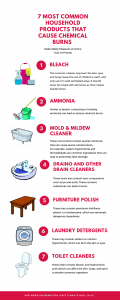The items we keep to clean our homes may be more dangerous than we realize. In fact, most households use substances that contain things like formaldehyde, dangerous acids, and petroleum distillates, which can cause serious damage if improperly applied. Do you have these popular items that may cause chemical burns on your property? And do you know how to respond after a burn injury?
Cleaners
- Bleach. This common cleaner may burn the skin, eyes, and lungs. Keep this out of children’s reach, and only use it in well-ventilated areas. It should never be mixed with ammonia, as that creates deadly fumes.
- Ammonia. Similar to bleach, contacting or inhaling ammonia can lead to serious chemical burns.
- Mold and mildew cleaner. These concoctions contain several chemicals that can cause severe complications. For example, sodium hypochlorite and formaldehyde are common ingredients that can lead to potentially fatal damage.
- Draino and other drain cleaners. These items also contain toxic components, such as lye and acids. These corrosive substances can lead to burns.
- Furniture polish. These may contain petroleum distillates, phenol, or nitrobenzene, which are extremely dangerous ingredients.
- Laundry detergents. These may contain sodium or calcium hypochlorite, which can burn the skin or eyes.
- Toilet cleaners. These often contain bleach, and hydrochloric acid (which can affect the skin, lungs, and eyes) is another common ingredient.
Though these cleaners may be a more obvious source of danger, other chemicals could be lurking around in your garage and car. Once your home is secured, check for hazards.
Car Items
- Air fresheners. Air fresheners may also contain formaldehyde. Some even include phenol, which could irritate the skin.
- Car polish. Polishes and waxes contain petroleum distillates; as mentioned, these solvents are a skin irritant that can aggravate the skin and contribute to more complex burns.
In the event of a chemical burn, the material causing the problem should be safely removed and isolated – gloves should be worn or a towel used to administer safe treatment. Any clothing or jewelry that may be contaminated should also be removed. The burn should be rinsed with water for at least 10 minutes and a loose bandage applied. The victim can take ibuprofen or acetaminophen to relieve pain.
If a person who has suffered a chemical burn goes into shock, is burned near the face, groin, or digits, or has a burn that goes through the first layer of skin or exceeds three inches in diameter, seek emergency help as soon as possible.
Keeping Yourself and Your Guests Safe
Home and business owners must do everything within their power to keep visitors safe. Before using a cleaner, read its warning labels and only apply it as directed. Lock unsafe items out of reach; if kids gain access to these substances and suffer chemical burns, you may be liable for the related burn injury treatment costs and any civil actions brought against you.
In West Virginia, if you or your child suffers a chemical burn, you may file a personal injury claim. For example, if a school janitor leaves cleaners in an unsafe area or uses them incorrectly, he or she may be responsible for subsequent damages. Similarly, if you suffer a chemical burn while patronizing a laundromat, you may be eligible for compensation.
These cases often hinge on collecting comprehensive evidence and demonstrating that the defendant acted negligently. After experiencing a burn, take pictures of the damage if possible. If you suspect a negligent party may be responsible for your pain and suffering, it’s a good idea to visit a doctor regardless of the severity. This information will likely affect the success of your claim. Contact Tiano O’Dell, PLLC for more information about your case and to schedule a free consultation with a West Virginia chemical burn lawyer.








